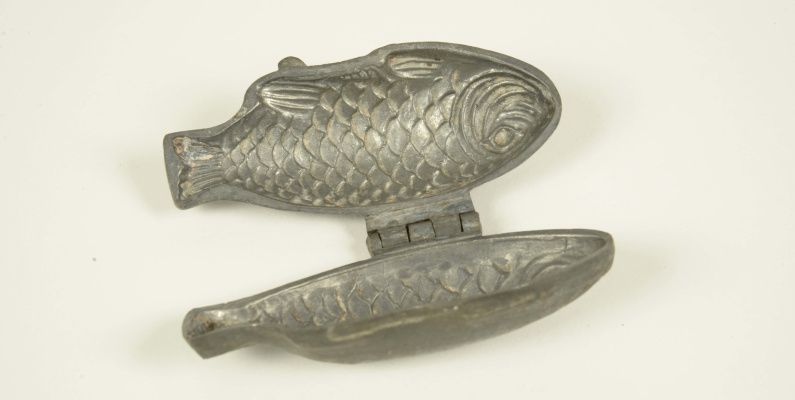
Summer and ice creams... it's a classic picture.
But imagine the moulded ice delicacies displayed and consumed a century or more ago, rather than today’s triple-scoop cone of assorted flavours.
Exotic frozen confectionary has a long history. There are 18th century recipes for parmesan ice cream, burnt filbert ice cream, and bergamot water ice. Modelling ices in the shape of unexpected objects has also enjoyed periods of great popularity. One writer suggests that between 2,000 and 3,000 different designs of hinged metal moulds have been made by various manufacturers.


Image: Fish-shaped mould | Otago Museum Collection
The Otago Museum has a small group of pewter ice cream moulds given to us by Mary Scorgie. We don’t know where or when she acquired them, but they probably date to the 19th century. Before moving to New Zealand in 1919 with her third husband, Peter, Mrs Scorgie had a hotel in Surrey. Perhaps the moulds relate to that stage of her life?
Ices became big business in the 19th century, but were a challenge for domestic kitchens before contemporary refrigeration technology was developed.
In 1866 Charles Hughes (late Chef de cuisine and Maître d’hôtel of the Trafalgar Tavern, Greenwich) advertised to the Auckland public that he had started making ices, ‘either cream or water, on the same principle as made in London’. He declared they would prove a great luxury and were strongly recommended by ‘Medical men’. Mr Hughes planned to supply hotels, restaurants and private houses with quantities of ‘Ice puddings in moulds or in small shapes, as a remove for second course, together with Dessert Ices.’ (New Zealand Herald, 23 January 1866: 6).


Image: Onion-shaped mould | Otago Museum Collection
The Star, in 1903, reprinted an article from the New York Sun, headed ‘Cooking Easier Now. The Modern Housewife and Her Predecessor’. It noted that the ‘facilities for attractive cookery were never so great as now… The department of moulds and fancy cutters alone is an imposing array… In a class by themselves are the ice cream moulds, big and little, representing all manner of shapes and embellishments’.
The Otago Museum’s moulds include an onion, a gherkin, a farm barn (with tree and animals), a fish, a rooster, a bundle of asparagus, and an anarchist’s bomb. The ice bomb would probably have had spun sugar flames emerging from the top.

Image: Exterior of anarchist's bomb-shaped mould | Otago Museum Collection

Image: Interior of cucumber/gherkin-shaped mould | Otago Museum Collection

Image: Farm barn mould | Otago Museum Collection

Image: Exterior of rooster mould | Otago Museum Collection
